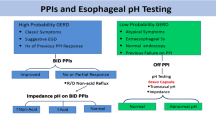Abstract
Introduction
Identifying gastroesophageal reflux disease as the cause of respiratory and laryngeal complaints is difficult and depends largely on the measurements of increased acid exposure in the upper esophagus or ideally the pharynx. The current method of measuring pharyngeal pH environment is inaccurate and problematic due to artifacts. A newly designed pharyngeal pH probe to avoid these artifacts has been introduced. The aim of this study was to use this probe to measure the pharyngeal pH environment in normal subjects and establish pH thresholds to identify abnormality.
Methods
Asymptomatic volunteers were studied to define the normal pharyngeal pH environment. All subjects underwent esophagram, esophageal manometry, upper and lower esophageal pH monitoring with a dual-channel pH catheter and pharyngeal pH monitoring with the new probe. Analyses were performed at 0.5 pH intervals between pH 4 and 6.5 to identify the best discriminating pH threshold and calculate a composite pH score to identify an abnormal pH environment.
Results
The study population consisted of 55 normal subjects. The pattern of pharyngeal pH environment was significantly different in the upright and supine periods and required different thresholds. The calculated discriminatory pH threshold was 5.5 for upright and 5.0 for supine periods. The 95th percentile values for the composite score were 9.4 for upright and 6.8 for supine.
Conclusion
A new pharyngeal pH probe which detects aerosolized and liquid acid overcomes the artifacts that occur in measuring pharyngeal pH with existing catheters. Discriminating pH thresholds were selected and normal values defined to identify patients with an abnormal pharyngeal pH environment.






Similar content being viewed by others
References
Koufman JA. The otolaryngologic manifestations of gastroesophageal reflux disease (GERD): a clinical investigation of 225 patients using ambulatory 24-hour pH monitoring and an experimental investigation of the role of acid and pepsin in the development of laryngeal injury. Laryngoscope 1991;101(4):1–7.
Koufman JA, Amin MR, Panetti M. Prevalence of reflux in 113 consecutive patients with laryngeal and voice disorders. Otolaryngol Head Neck Surg 2000;123(4):385–388. [. Erratum in: Otolaryngol Head Neck Surg 2001; 124. 1:104. doi:10.1067/mhn.2000.109935.
Oelschlager BK, Chang L, Pope CE 2nd, Pellegrini CA. Typical GERD symptoms and esophageal pH monitoring are not enough to diagnose pharyngeal reflux. J Surg Res 2005;128(1):55–60.
Jacob P, Kahrilas PJ, Herzon G. Proximal esophageal pH-metry in patients with ‘reflux laryngitis’. Gastroenterology 1991;100(2):305–310.
Wo JM, Hunter JG, Waring JP. Dual-channel ambulatory esophageal pH monitoring, a useful diagnostic tool? Dig Dis Sci 1997;42(11):2222–2226. doi:10.1023/A:1018802330957.
Patti MG, Arcerito M, Tamburini A et al. Effect of laparoscopic fundoplication on gastroesophageal reflux disease- induced respiratory symptoms. J Gastrointest Surg 2000;4:143–149. doi:10.1016/S1091-255X(00)80050-5.
Wiener GJ, Koufman JA, Wu WC et al. Chronic hoarseness secondary to gastroesophageal reflux disease: documentation with 24-h ambulatory pH monitoring. Am J Gastroenterol 1989;84(12):1503–1508.
Wo JM, Jabbar A, Winstead W et al. Hypopharyngeal pH monitoring artifact in detection of laryngopharyngeal reflux. Dig Dis Sci 2002;47(11):2579–2585. doi:10.1023/A:1020584731503.
Cherry J, Margulies SI. Contact ulcer of the larynx. Laryngoscope 1968;78(11):1937–1940. doi:10.1288/00005537-196811000-00007.
Kaufman JA, Houghland JE, Quiroga E. Long-term outcomes of laparoscopic antireflux surgery for gastroesophageal reflux disease (GERD)-related airway disorder. Surg Endosc 2006;20(12):1824–1830. doi:10.1007/s00464-005-0329-9.
Wo JM, Koopman J, Harrell SP et al. Double-blind, placebo-controlled trial with single-dose pantoprazole for laryngopharyngeal reflux. Am J Gastroenterol 2006;101(9):1972–1978. doi:10.1111/j.1572-0241.2006.00693.x.
Cool M, Poelmans J, Feenstra L et al. Characteristics and clinical relevance of proximal esophageal pH monitoring. Am J Gastroenterol 2004;99(12):2317–2323. doi:10.1111/j.1572-0241.2004.40626.x.
Mathus-Vliegen EM, Smit CF et al. Artifacts in 24-h pharyngeal and oesophageal pH monitoring: is simplification of pH data analysis feasible? Scand J Gastroenterol 2004;39(1):14–19. doi:10.1080/00365520310007341.
Harrell SP, Koopman J, Woosley S et al. Exclusion of pH artifacts is essential for hypopharyngeal pH monitoring. Laryngoscope 2007;117(3):470–474. doi:10.1097/MLG.0b013e31802d344c.
Ayazi S, Lipham JC, Portale G et al. Bravo catheter-free pH monitoring: normal values, concordance, optimal diagnostic thresholds, and accuracy. Clin Gastroenterol Hepatol 2009;7(1):60–67. doi:10.1016/j.cgh.2008.08.020.
Tuttle SG, Ruffin F, Bettarrella A. The physiology of heartburn. Ann Intern Med 1961;55:292–300.
Weusten BL, Akkermans LM, vanBerge-Henegouwen GP et al. Spatiotemporal characteristics of physiological gastroesophageal reflux. Am J Physiol 1994;266(3 Pt 1):G357–G362.
Korsten MA, Rosman AS, Fishbein S, Shlein RD, Goldberg HE, Biener A. Chronic xerostomia increases esophageal acid exposure and is associated with esophageal injury. Am J Med 1991;90:701–706.
Sonnenberg A, Steinkamp U, Weise A, Berges W, Wienbeck M, Rohner HG, Peter P. Salivary secretion in reflux esophagitis. Gastroenterology 1982;83:889–895.
Acknowledgements
The investigators wish to thank Miss Paula Corsetti, RN, and Mrs. Cheryl Correia, MBA, without their perseverance and support this study would not have progressed.
Author information
Authors and Affiliations
Corresponding author
Additional information
The study was supported by a grant from the Respiratory Technology Corp. T.R. DeMeester is on the scientific advisory board of Respiratory Technology Corp.
Rights and permissions
About this article
Cite this article
Ayazi, S., Lipham, J.C., Hagen, J.A. et al. A New Technique for Measurement of Pharyngeal pH: Normal Values and Discriminating pH Threshold. J Gastrointest Surg 13, 1422–1429 (2009). https://doi.org/10.1007/s11605-009-0915-6
Received:
Accepted:
Published:
Issue Date:
DOI: https://doi.org/10.1007/s11605-009-0915-6




